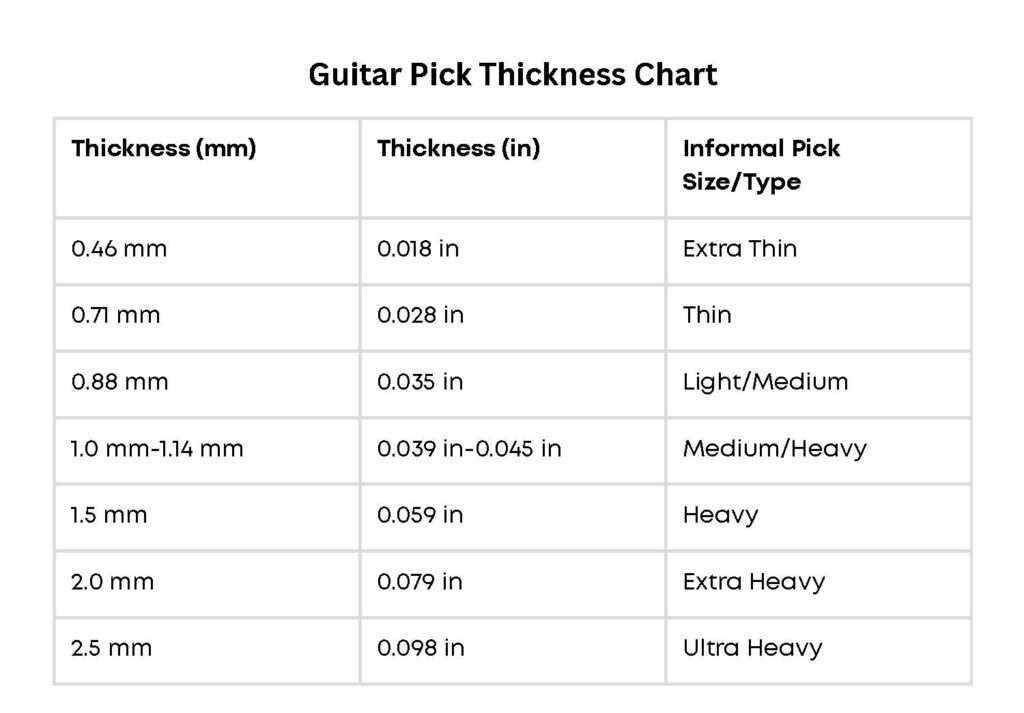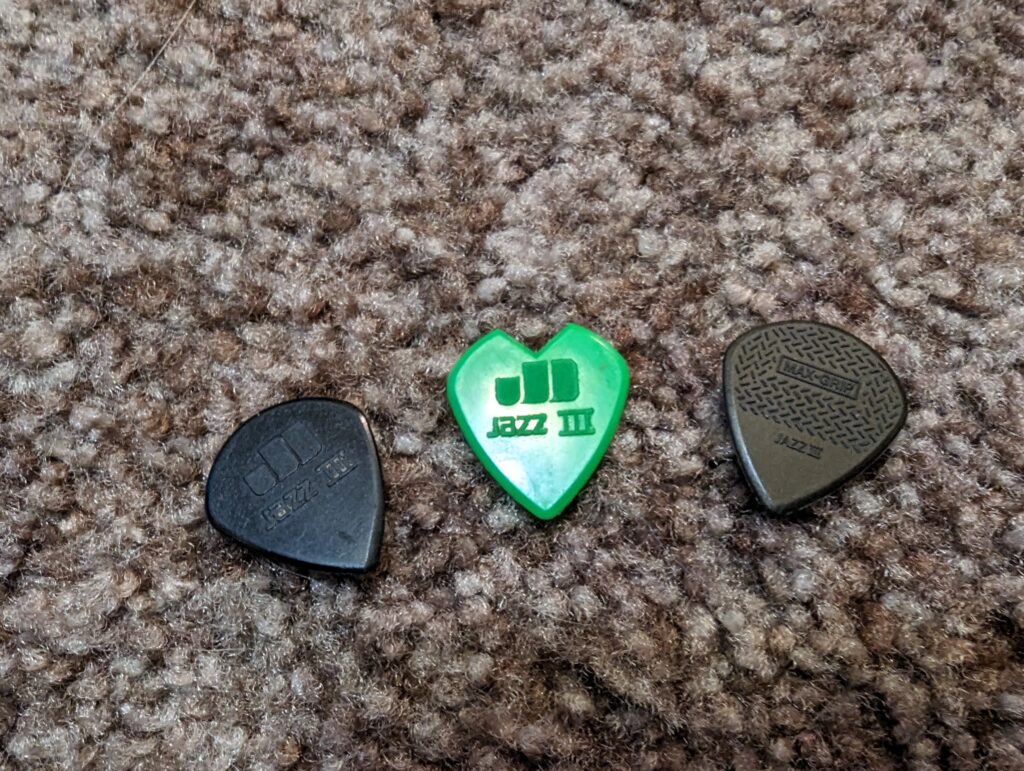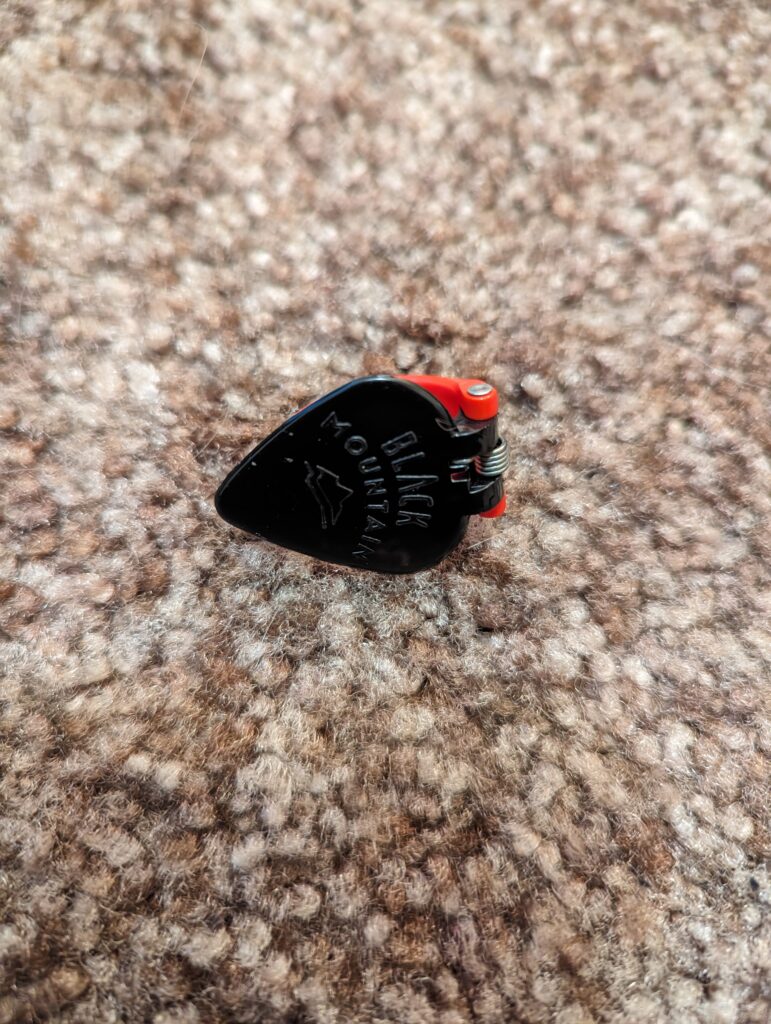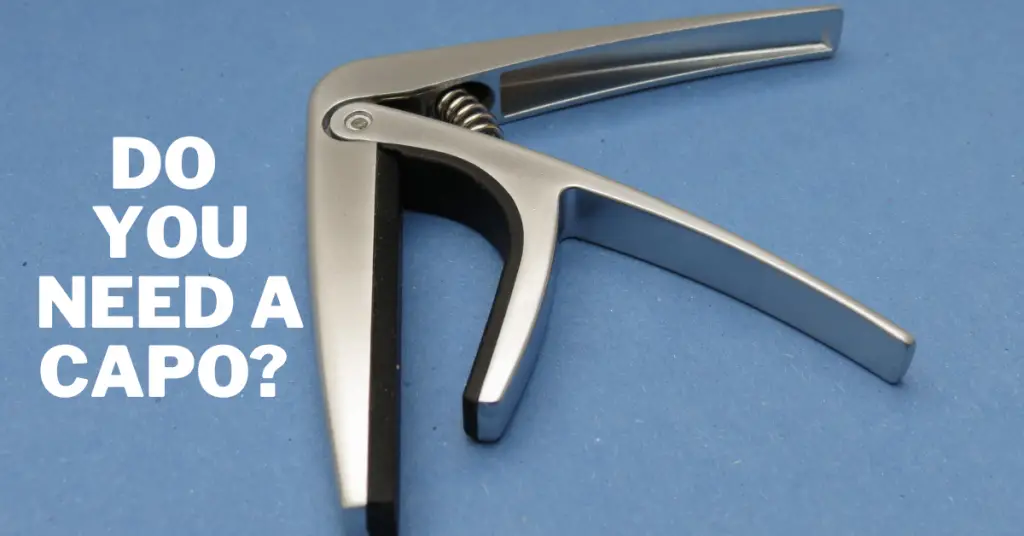Discover the importance of guitar pick thickness and how it can affect your playing style and sound. Learn about the different options available and find the perfect pick thickness for your musical preferences.
You know what they say: get your kids hooked on guitar picks and they won’t have money for… You know, bad stuff.

Jokes aside, finding an ideal pick and guitar pick thickness for you is an adventure. And as a guitar player for over 17 years now, I can tell you there are a lot of great picks.
You’ll always be experimenting with picks, but it’s good to have a standard, go-to pick size.
Enough talk. Let’s dive in.
3 steps to find your perfect guitar pick
There are basically 3 steps to find your perfect guitar pick:
- Decide on your ideal guitar pick thickness using my chart
- Test a variety of guitar pick materials
- Find your favorite guitar pick shapes

You’ll dive deep into all 3 of these steps below.
Guitar pick thickness chart

Here’s a guitar pick thickness chart to giving common pick sized in both inches (in) and millimeters (mm).
The informal pick sizes column gives you a general idea for guitar pick names. However, the informal pick size names can vary between different pick manufacturers.
| Thickness (mm) | Thickness (in) | Informal Pick Size/Type |
| 0.46 mm | 0.018 in | Extra Thin |
| 0.71 mm | 0.028 in | Thin |
| 0.88 mm | 0.035 in | Light/Medium |
| 1.0 mm-1.14 mm | 0.039 in-0.045 in | Medium/Heavy |
| 1.5 mm | 0.059 in | Heavy |
| 2.0 mm | 0.079 in | Extra Heavy |
| 2.5 mm | 0.098 in | Ultra Heavy |
Download the Guitar Pick Thickness Chart PDF
Guitar pick thickness dimensions
Here are some brief descriptions of the informal pick sizes/types.
Personal preference plays a significant role in pick selection, so try out different thicknesses to find the one that suits your guitar playing.
Extra thin
Extra Thin (0.46 mm / 0.018 in): Extra thin picks are extremely lightweight and flexible. They produce a very bright and “delicate” tone, making them suitable for strumming on acoustic and classical guitars.
I’ve also seen them used by some incredible jazz guitar players, such as Robert Conti.
They’re often favored by players who prefer a softer attack and minimal resistance against the strings.
Thin
Thin (0.71 mm / 0.028 in): Thin picks offer a bit more rigidity than extra thin picks, providing a lot of flexibility, but not much alternate picking control.
They’re arguably best for strumming and jazz guitar. This is due to the clear tone and light volume produced by thin picks.
Medium
Medium (0.88 mm / 0.035 in – 1.0 mm / 0.039 in): Medium picks are the “all-purpose” pick for many guitarists. They offer enough rigidity for semi-precise picking and controlled strumming, while still allowing for some flexibility.
Medium picks produce a balanced tone with a moderate attack and are well-suited for various genres and playing techniques.
Medium/Heavy
Medium/Heavy (1.14 mm / 0.045 in): Picks in this range provide increased stability and control. They’re suitable for players who prefer a stronger attack and more resistance against the strings.
These picks are often used for rock and more aggressive playing styles, producing a pronounced tone with a decent amount of brightness.
Heavy
Heavy (1.5 mm / 0.059 in): Heavy picks offer substantial rigidity, making them ideal for intense picking and lead playing.
They produce a strong attack and a full-bodied tone with a good amount of volume.
Heavy picks are favored by players who need maximum control and precision during fast leads.
Extra Heavy
Extra Heavy (2.0 mm / 0.079 in): Extra heavy picks are thick and solid, providing the most resistance against the strings.
They’re primarily used by players who demand maximum control and articulation, such as shredders and metal guitarists. These picks produce a powerful attack and a bold, focused tone.
I use extra heavy picks myself, and I prefer the Big Stubby. You’ll learn more about the Big Stubby in the “Pick materials” section of this post.
Best guitar pick thickness
There is no definitie “best guitar pick thickness. It is subjective, and depends on several factors, including play style, musical genre, and your personal preferences.
Now, do I believe there is a best guitar pick thickness for certain styles and genres? You bet I do. But still, it’s subjective.
At the end of the day, there is no one-size-fits-all answer, as different pick thicknesses offer distinct advantages for various techniques and tones.
To help you find your ideal thickness, here are some guidelines and considerations:
Playing Style
Consider your primary playing style.
If you predominantly strum chords and play rhythm guitar, you might prefer a thinner pick for its flexibility and smooth strumming. If you focus on intricate lead playing, a thicker pick will provide better control and articulation.
Genre
Different musical genres often benefit from specific pick thicknesses.
For example, acoustic folk players might lean toward thinner picks for their gentle tone, while metal guitarists might opt for thicker picks for aggressive attack and precision.
Tone
Thinner picks generally produce a brighter and softer tone, while thicker picks tend to provide a fuller, more pronounced sound.
Consider the tonal qualities you’re aiming for in your playing.
Comfortability
Personal comfort is crucial. Some players prefer the flexibility of a thin pick, while others like the sturdiness of a thicker pick.
Try different thicknesses to see what feels most comfortable in your hand.
Speed and precision
Thicker picks will generally offer better control and accuracy for intricate guitar playing.
Experimentation
It’s a good idea to try picks of different thicknesses to see how they affect your playing. Your preference might change over time.
You may also need a specific pick based on the music you’re working on.
Variability
Don’t feel limited to just one pick thickness. Many guitarists keep a variety of picks on hand to suit different playing situations.
Pick sizes: Thin vs. Medium vs. Heavy
The easiest way to break down and compare pick sizes is by thin, medium, and heavy picks. Here’s a table comparing the sound differences of all 3 sizes:
| Aspect | Thin Picks | Medium Picks | Heavy Picks |
|---|---|---|---|
| Attack | Gentle attack with less resistance. | Balanced attack with moderate resistance. | Strong attack with noticeable resistance. |
| Tone | Brighter tone with less emphasis on bass. | Balanced tone with moderate bass and treble. | Warmer tone with more pronounced bass. |
| Flexibility | High flexibility, bends easily. | Moderate flexibility, some give but not floppy. | Low flexibility, maintains shape during playing. |
| Articulation | Might lack precision in fast picking. | Good balance between precision and flow. | Offers precise note definition in picking. |
| Strumming | Suitable for light strumming and rhythm. | Works well for various strumming patterns. | Might be less suited for very light strumming. |
| Single Note Picking | Can lack clarity in rapid single-note runs. | Offers a balance between clarity and fluidity. | Provides clear note separation in picking runs. |
| Chords | Might lack definition in complex chords. | Adequate for chord playing across the neck. | Good for clear chord voicing and definition. |
| Dynamic Range | Limited dynamic range due to flexibility. | Moderate dynamic range for various styles. | Offers a wider dynamic range for expression. |
| Control | Requires a delicate touch for control. | Offers a balance between control and ease. | Offers good control for precise playing. |
| Playing Speed | Better for slower to moderate playing speeds. | Versatile for various playing speeds. | Incredibly useful for high speeds. |
Thin vs. Medium vs. Heavy Guitar Picks PDF
Common guitar pick materials
There are a lot of different guitar pick materials, especially in today’s world of product innovation and experimentation.
Below, you’ll look at 6 different guitar pick materials, which are arguably the most common materials.
Each of these guitar pick materials has unique characteristics, and the best choice of material for you depends on your playing style, musical interests, and personal preferences.
Go to a local guitar store and try out a variety of picks to get a feel for which material works best for you.
Celluloid/Cellulose
Celluloid is a traditional material used for guitar picks. It’s made from a type of plastic derived from cellulose.
This is the most common type of guitar pick material, and most players’ first guitar picks are made from it.
Celluloid picks are known for their warm tone and smooth feel.
They can provide a bit of flexibility and are great for strumming and producing a classic sound, especially on acoustic guitars. However, they wear down over time with heavy use.
They also produce a flappy sound, which doesn’t sound great.
Nylon
Nylon is another common guitar pick material due to its versatility.
Nylon picks are generally inexpensive, but I consider them to be a step-up from the cellulose guitar picks.
They offer a balanced tone and are available in various thicknesses, but are generally sold at a thin to medium (0.60 mm- 0.88 mm) thickness.
They also have grip-improving materials, which decreases the chance the pick will slip away from you.
Acetal
Acetal picks are where you’ll start to see guitar picks gain durability, and as a shred guitar player, I love durability.
They’re sturdy and have a decent amount of flexibility. However, they’re often too thin for me, but give them a shot if you’re a beginner or intermediate player.
Remember, it’s good to try out every type of guitar pick.
Delrin
Truly, especially if you’re an electric guitar player, go and test out a Delrin guitar pick ASAP.
And how could you not, considering that Misha Mansoor uses a Delrin Flow Pick?
They’re made of a super durable synthetic polymer, and usually have a thick (1.0mm-2.0mm) guitar pick thickness.
Delrin is also resistant to wear, which makes them ideal for aggressive pickers, like our main man Misha Mansoor.
You’ll most commonly see this material used for the Jim Dunlop Primegrip and Tortex picks. The Tortex picks are arguably the most common thick guitar pick, and have the adorable turtle on them.
Ultem
Ultem picks are made from a high-quality thermoplastic material that combines stiffness with a neutral tone.
The most popular of these is arguably the Dunlop Ultex, which is not a bad pick in my opinion.
They are sturdy and durable, so no need to worry about flapping with these bad boys.
Acrylic
Acrylic picks are my go-to guitar picks, in particular the Big Stubby picks. Gravity Picks are another popular acrylic pick brand, and are not a bad alternative to the Big Stubby.
Acrylic picks are transparent and have a bunch of fun colors and designs. They’re known for their stiff, but comfortable feel. The stiffness leads to excellent control and accuracy, which is especially useful for high-speed shred fanatics.
They have a slightly different feel compared to traditional materials, but I love it. On top of this, they’re generally quite thick. The Big Stubby I use has a 3.0mm thickness. Crazy, right?
Guitar pick shapes
Guitar pick shapes are just as important as thickness and materials. Your ideal guitar pick shape can greatly affect your playing and grip comfortability.
And just like guitar pick materials, it’s important to try out a wide variety of guitar pick shapes to see which one works best for you.
Make sure you consider your technical approach and playing style when you decide on your ideal pick shape.
Here are some common pick shapes:
Standard (teardrop) picks
Standard (Teardrop) Picks: The standard pick shape is a classic teardrop design with a rounded tip and a slightly pointed end.
This is the most widely used pick shape and never seems to fail the average guitar player.
You’ll find teardrop guitar picks in nearly every guitar player’s pick arsenal, from beginner to advanced.
Tri-tip picks (triangle)
Tri-tip Picks: Triangle picks have three equal sides and come to a point. They’re generally made of acrylic, and generally offer more surface area to grip.
And if you wear down one side, you can switch to another!
And if you drop the pick, you won’t need to worry about picking it up and starting on the wrong side, because the picks 3 angles are the same!
Triangle picks are especially great for acoustic and bass players looking for a versatile pick.

Jazz picks
Jazz Picks (Dunlop Jazz III): Jazz picks are smaller and more compact, with a sharp point. The Dunlop Jazz III is a well-known example of this shape, and is one of the most popular shred guitar picks ever!
The small size puts an emphasis on the tip of your pick, which tends to improve picking accuracy, and remove unnecessary amounts of pick.
They are especially popular among players who focus on precise, fast picking.

Jumbo jazz picks
Jumbo Jazz Picks: Jumbo jazz picks are exactly what they sound like: bigger versions of traditional jazz picks.
This means you get the sharp point and comfortable feel of a jazz pick in a larger size. This is great for guitarists that hate small pick sizes, but want the precision of a jazz III.
One of my favorite examples of a jumbo jazz pick is a John Petrucci signature jazz III pick.

Thumb picks
Thumb Picks: Thumb picks are designed to be worn on the thumb and are often used for fingerpicking styles, especially travis picking.
They have a curved or angled pick attached to a loop that fits around the thumb, allowing the player to simultaneously pick individual notes with their other fingers.

Chet Atkins made great use of thumb picks.
And it’s videos like this one that distract me when I’m making these posts.
Novelty picks
Novelty Picks: These picks come in various shapes, often related to pop culture references or personal interests
While they might not be the most practical for serious playing, they can be fun to have and use occasionally.
Holey Picks
Holey Picks: Some picks have holes or cutouts to reduce their weight and increase flexibility.
These are not super common, but don’t let that deter you! They can offer a unique feel and sound and are often preferred by players who want a lighter touch.
Swiss Picks make great holey picks, used by players such as Rusty Cooley and Brett Stine.
Guitar pick thickness guide summary
Choosing your ideal guitar pick thickness is the first step in deciding on your perfect guitar pick. It depends on your playing style, ideal tone, and overall personal preferences.
Try out a wide variety of pick materials and pick shapes from there. After doing this you’ll find your ideal guitar pick, and then you’re off to the races!



